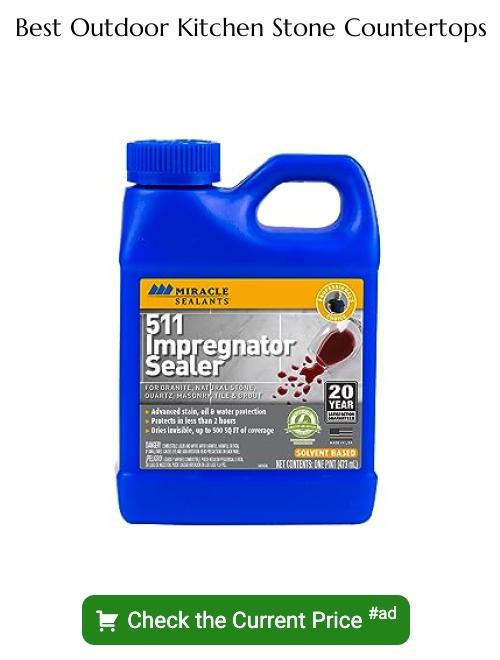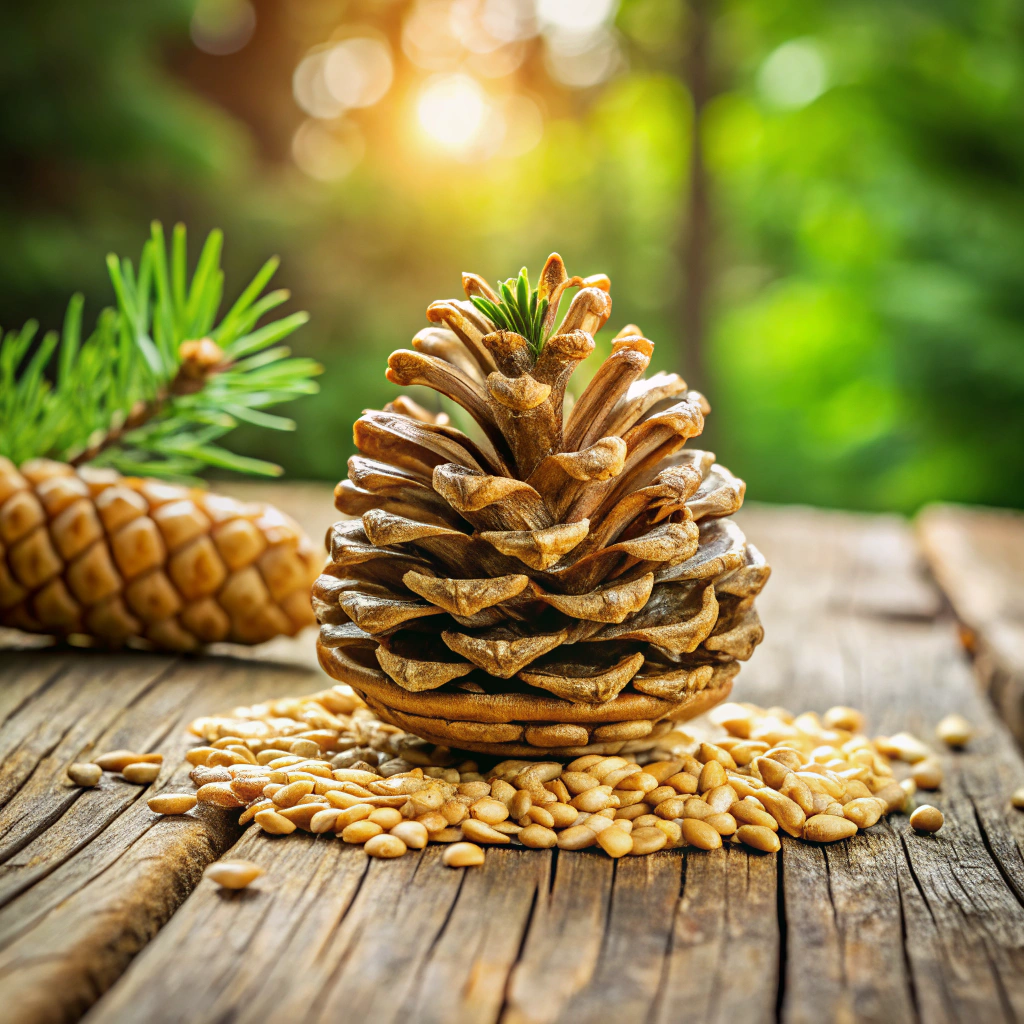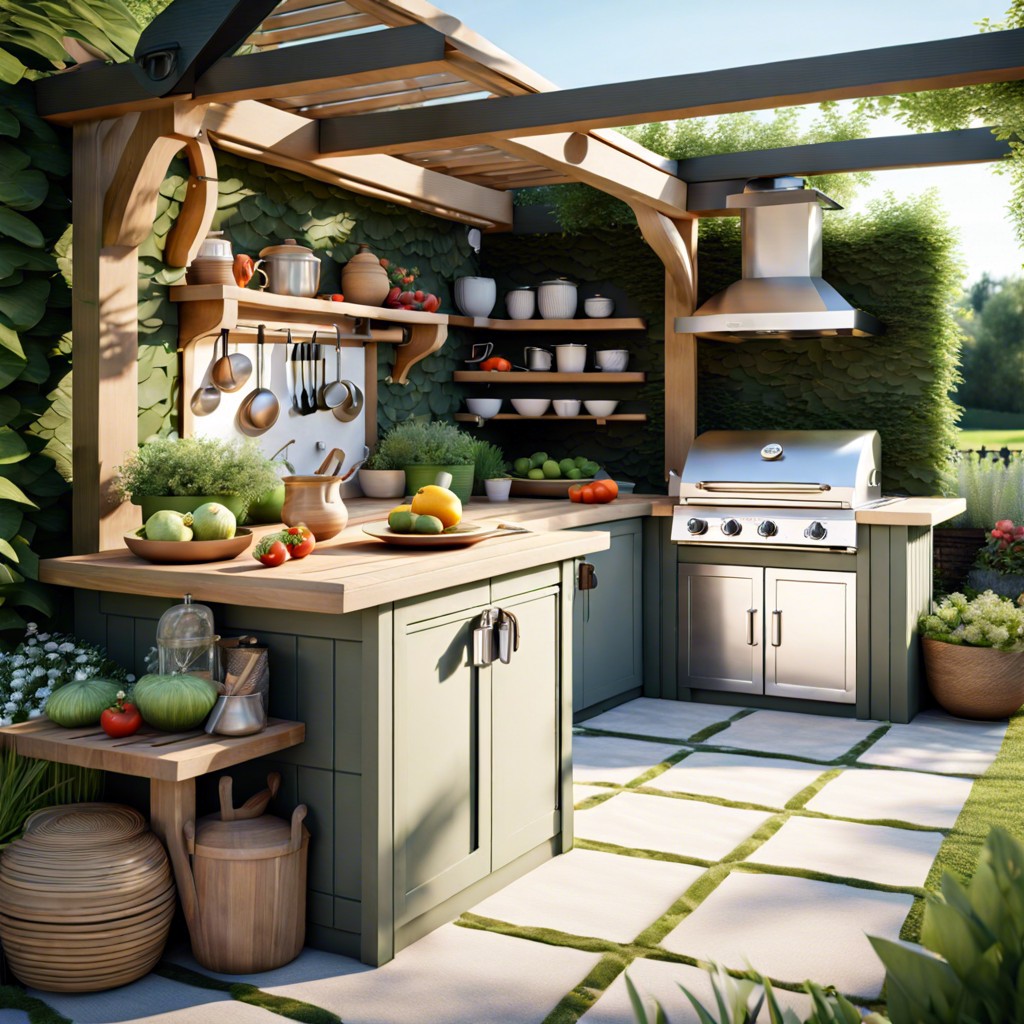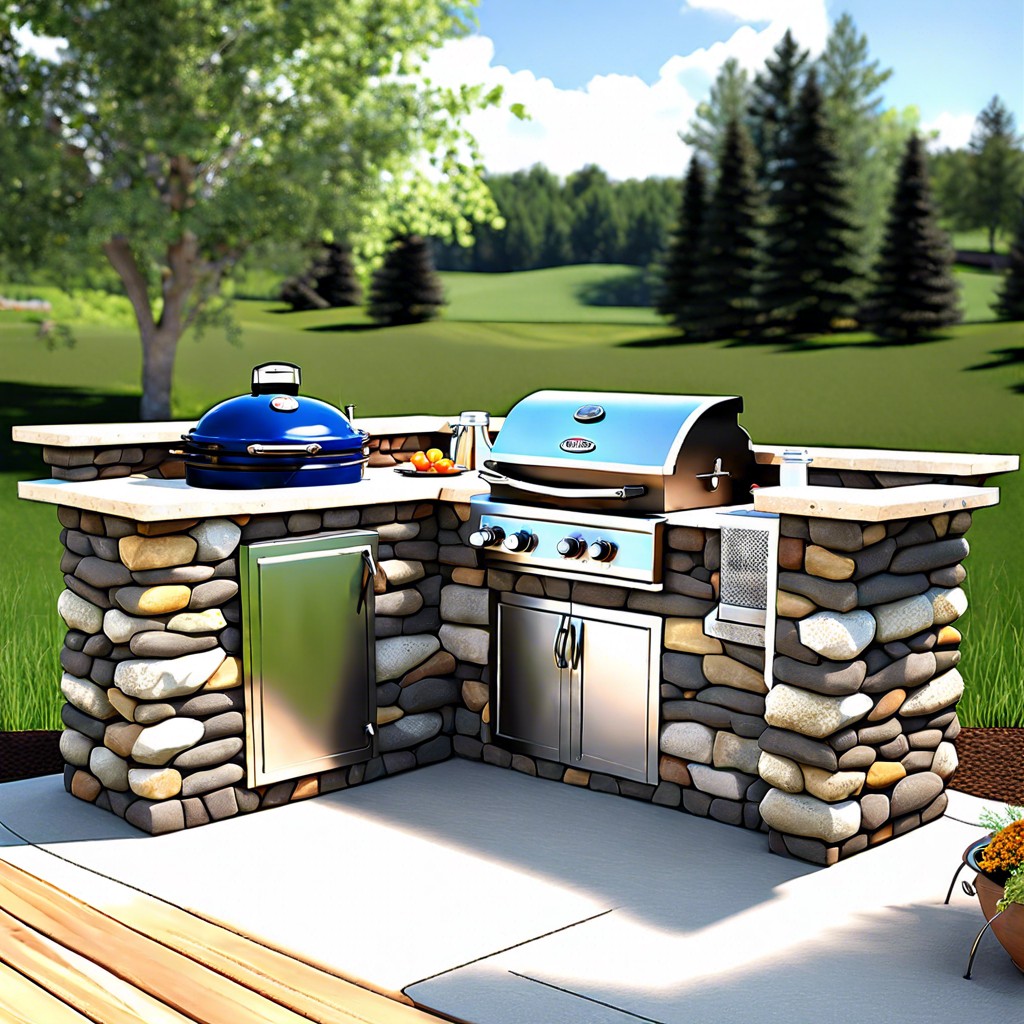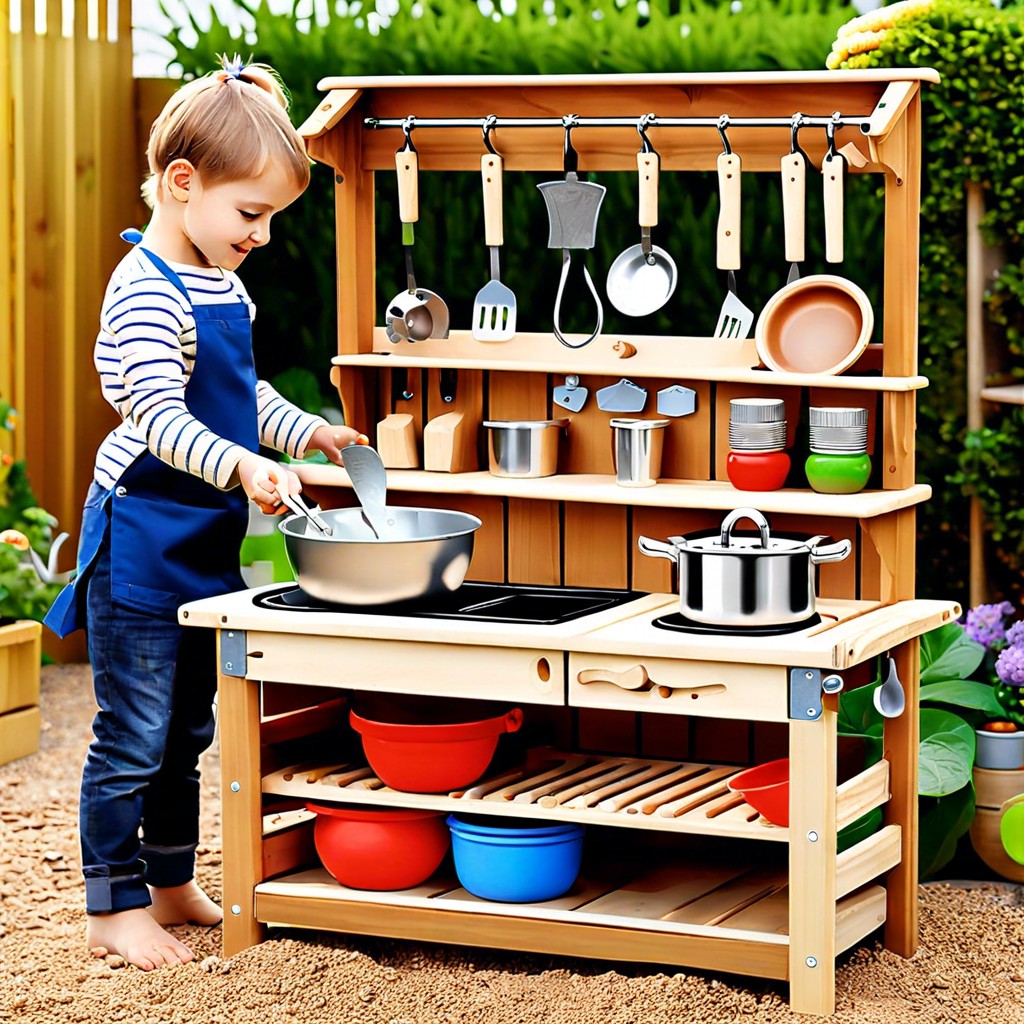Last updated on
Discover the art of constructing a stunning stone outdoor kitchen that elevates your backyard gatherings and enhances your culinary skills.
Outdoor kitchens are becoming increasingly popular among homeowners who want to enjoy cooking and dining al fresco. And what better way to create a stunning outdoor kitchen than by using natural stone? Stone is not only durable and long-lasting but also adds a touch of elegance and sophistication to any outdoor space.
In this article, we will guide you through the process of building a stone outdoor kitchen, from selecting the right materials to designing the layout and installing appliances. So grab your hard hat and let’s get started!
What's Inside
Choosing the Right Location
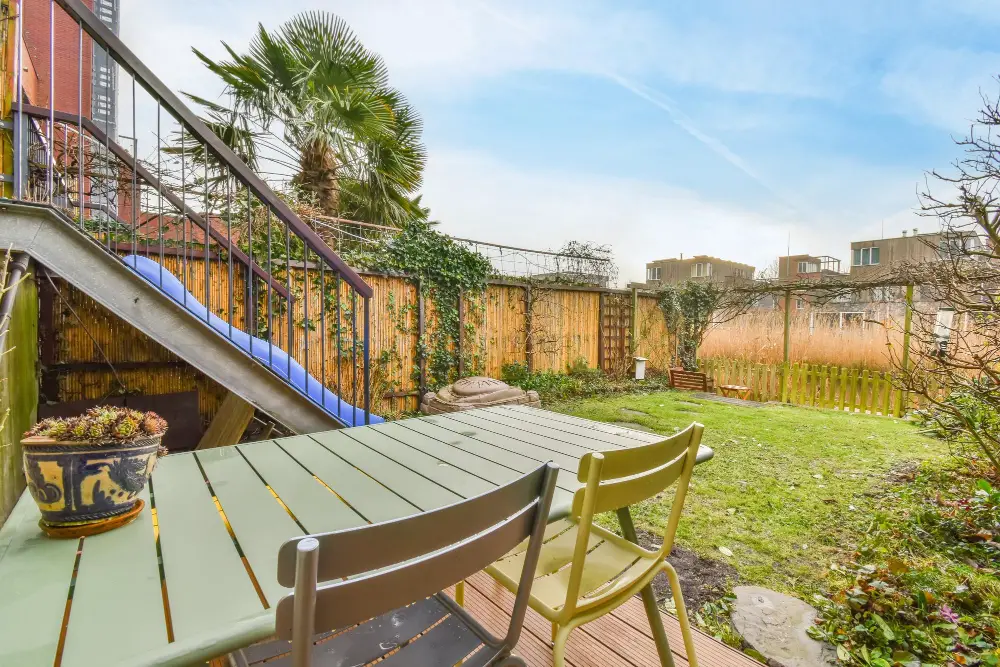
You want to select an area that is easily accessible from your indoor kitchen and dining room, but also provides enough space for cooking, seating, and entertaining. Consider the natural elements of your backyard such as sunlight exposure, wind direction, and drainage when selecting a spot for your outdoor kitchen.
It’s important to choose a level surface with good drainage so that water doesn’t pool around or under the structure. If you’re planning on installing appliances like refrigerators or sinks in your outdoor kitchen design then make sure there are nearby electrical outlets and plumbing connections available.
Another factor to consider when choosing the location of your stone outdoor kitchen is privacy. You don’t want neighbors peeking over fences while you’re grilling up dinner! A secluded corner of the yard can provide some much-needed privacy while still allowing easy access from inside.
Designing Your Outdoor Kitchen
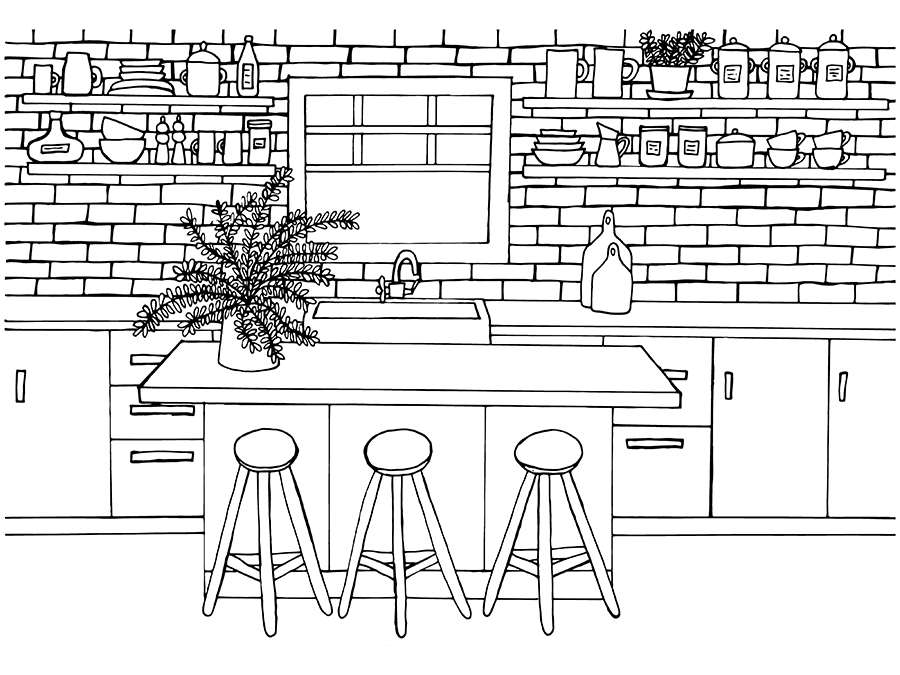
It’s essential to consider how you plan to use the space, what appliances you’ll need, and how many people will be using it. You should also think about the overall style and aesthetic of your home and backyard when designing your outdoor kitchen.
One important factor to keep in mind is traffic flow. Your design should allow for easy movement between cooking stations, dining areas, and other features like fire pits or seating areas.
Consider creating separate zones for different activities so that multiple people can use the space at once without getting in each other’s way.
Another aspect of designing an outdoor kitchen is selecting materials that complement both your home’s architecture as well as its surroundings. Natural stone such as granite or slate can add texture while stainless steel gives a modern look.
Don’t forget about lighting! Proper illumination not only enhances safety but also creates ambiance after dark by highlighting key features such as countertops or grilling stations.
Types of Outdoor Kitchen Stone
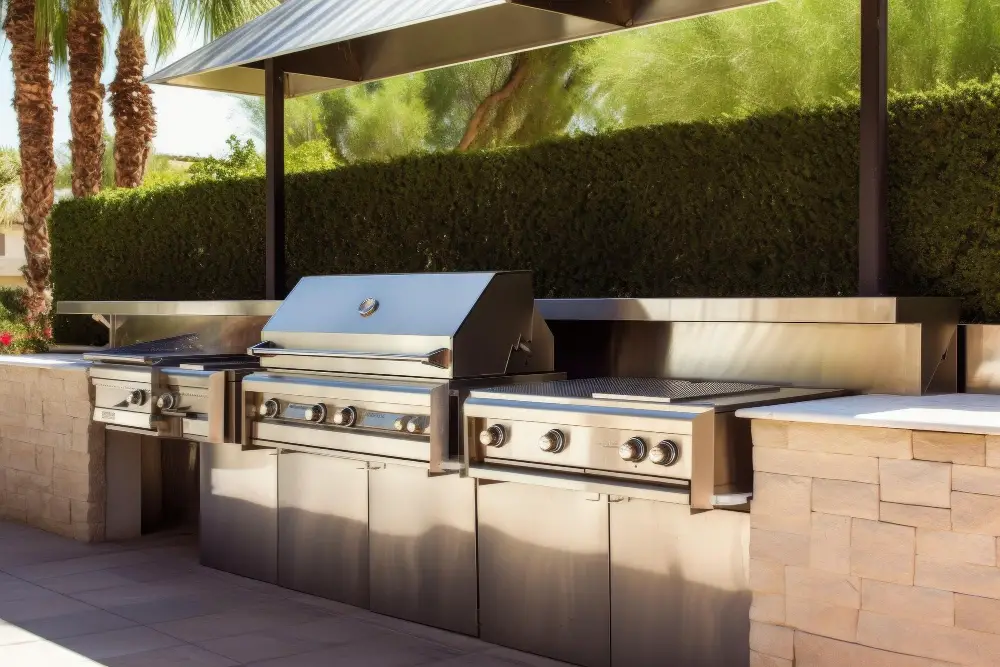
Not only does it affect the overall look and feel of your outdoor space, but also its durability and maintenance requirements. There are several types of natural stones that are commonly used for outdoor kitchens, including granite, slate, limestone, travertine and sandstone.
Granite is one of the most popular choices due to its strength and resistance to heat and scratches. It’s available in various colors such as black or white with speckles or veins running through them.
Slate has a unique texture that adds character to any design while being slip-resistant when wet. It’s perfect for flooring options since it can withstand heavy foot traffic without showing wear easily.
Limestone offers an earthy appearance with warm tones ranging from beige to brownish-gray hues which make them ideal for countertops or backsplashes.
Travertine has a porous surface that gives off an elegant look while providing excellent traction underfoot even when wet making this material great for poolside areas too!
Sandstone provides natural beauty with varying shades from light tan all way up until dark reds depending on where they were quarried; these stones work well as accent pieces around grilling stations or fire pits.
Easy Stone Outdoor Kitchen Design
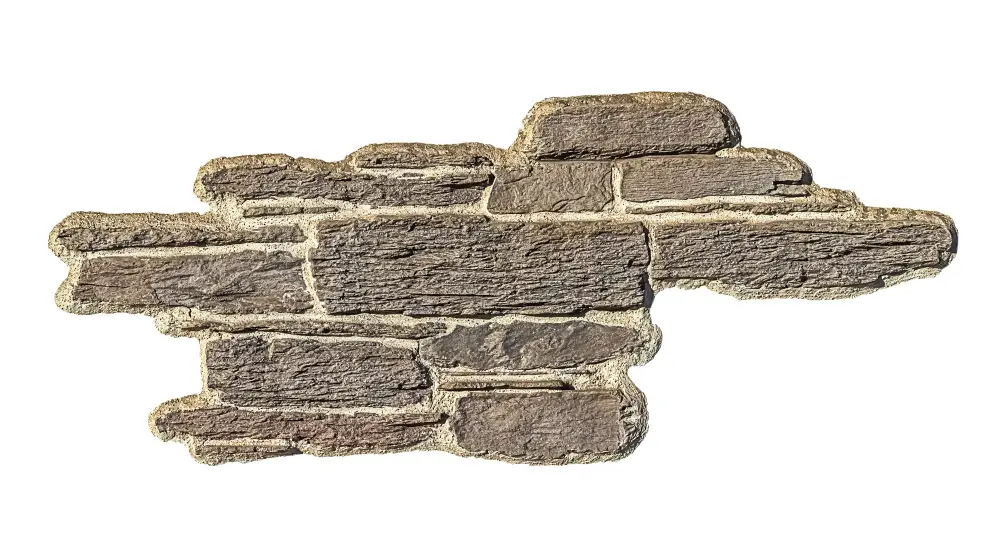
Don’t worry, there are easy ways to create a beautiful stone outdoor kitchen without breaking the bank or spending months on construction. One of the easiest design options is to use prefabricated stone panels that come in various sizes and shapes.
These panels are made from natural stones such as granite, limestone, or slate and can be easily installed over your existing frame.
Another option is to choose modular kits that include all the necessary components for building an outdoor kitchen quickly and efficiently. These kits usually come with pre-cut countertops, cabinets, drawers, sinks and appliances that fit together seamlessly like puzzle pieces.
If you prefer a more customized look but still want something simple and straightforward then consider using stacked stone veneer for your project. Stacked stones give off a rustic yet modern vibe while being relatively easy to install compared with other types of masonry work.
Stone Pattern Options
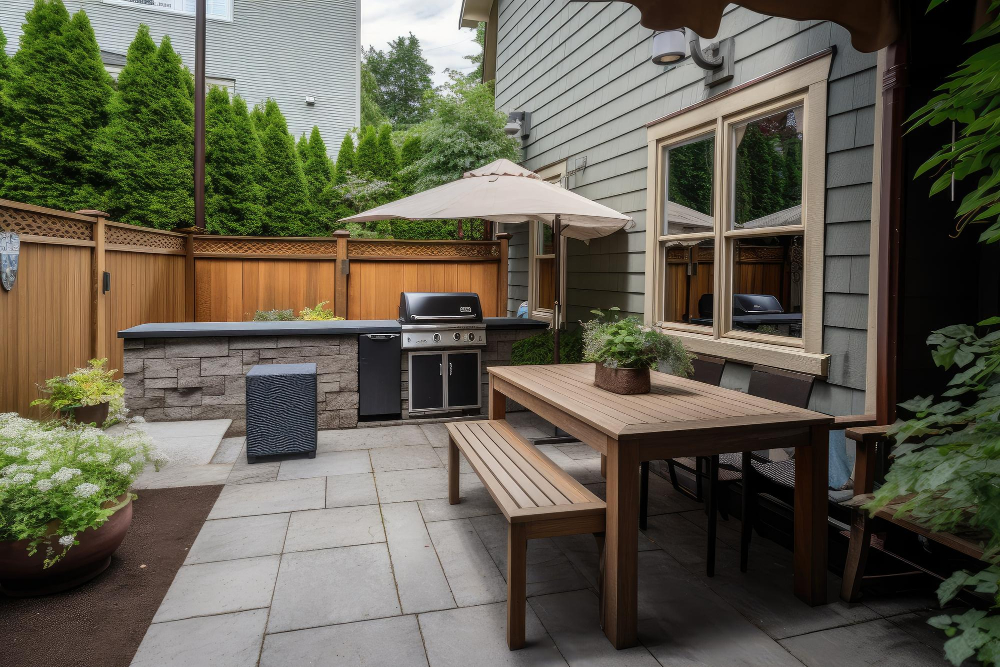
Stone patterns not only add visual interest but also create texture and depth in your design. There are several options available when it comes to selecting a stone pattern for your outdoor kitchen.
One popular option is the stacked stone pattern, which involves stacking stones on top of each other without any visible grout lines. This creates a natural and rustic look that works well with traditional or modern designs.
Another option is the herringbone pattern, which involves laying stones at an angle to create a zigzag effect. This adds movement and dimensionality to your design while still maintaining a classic look.
For those who prefer something more intricate, there’s always the basket weave or diamond patterns that involve alternating rectangular or square-shaped stones in different directions for added visual appeal.
Ultimately, choosing the right stone pattern depends on personal preference as well as how it complements other elements of your outdoor space such as landscaping features and furniture choices.
Selecting the Best Materials
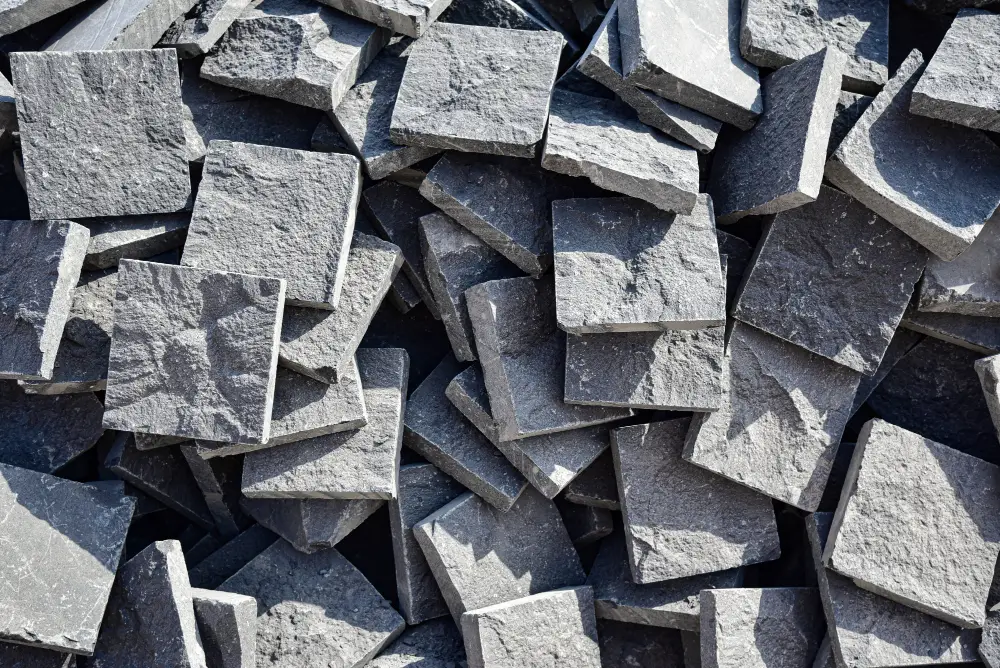
First and foremost, you want to choose high-quality stones that can withstand the elements and heavy use. Natural stones like granite, slate, limestone or sandstone are popular choices due to their durability and resistance against heat and moisture.
Another factor is color selection; natural stone comes in various shades of gray, brown or beige which can complement any backyard design scheme. You may also opt for manufactured stone veneers that mimic natural stones but offer more flexibility in terms of shape and size.
It’s important not only to select quality materials but also ones that fit within your budget constraints. Keep in mind that while some types of natural stone may be more expensive upfront than others (such as granite), they often require less maintenance over time compared with cheaper alternatives like concrete pavers.
Building the Foundation
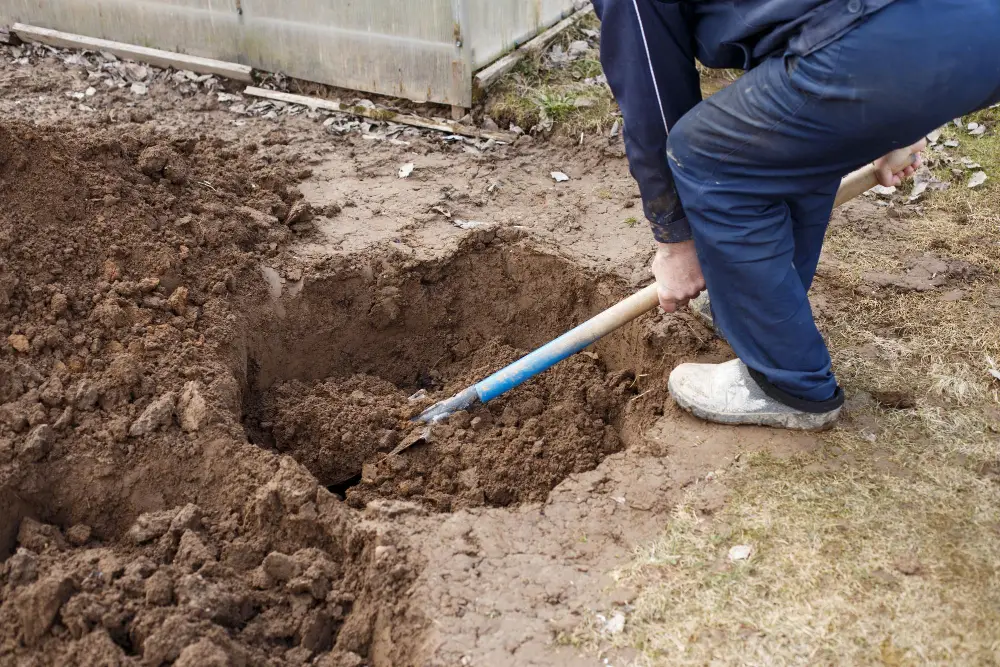
The foundation will support the weight of the structure and ensure that it remains stable over time. To begin, mark out the area where you want to build your outdoor kitchen using stakes and string.
Then dig down about 6 inches deep into the ground within this marked-out area.
Next, fill in this dug-out space with crushed gravel or crushed stone until it is level with surrounding soil or ground level. Use a tamper tool to compact each layer of gravel as you add them for stability.
Afterward, spread sand on top of the compacted gravel base and use a screed board (a long straight board) to smooth out any bumps or unevenness in preparation for laying concrete blocks.
Place concrete blocks around all four sides of your marked-out area at intervals no more than 4 feet apart from one another along each side; these will serve as pillars supporting beams that hold up countertops later on during construction process.
Constructing the Frame
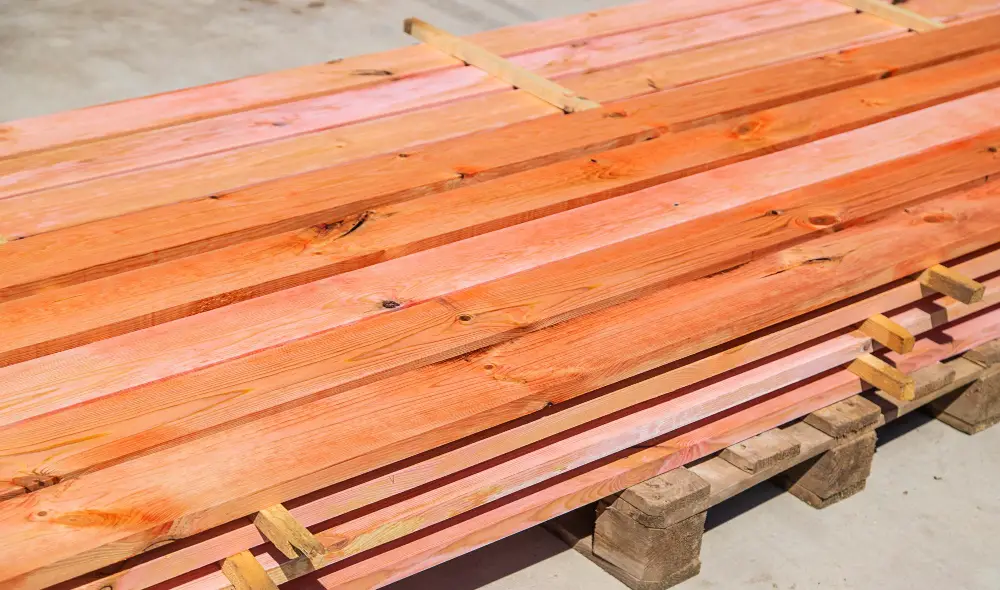
The frame is essentially a skeleton that supports the weight of your appliances and countertops. It also provides stability to ensure that your outdoor kitchen stays upright during harsh weather conditions.
When constructing the frame, it’s important to use sturdy materials such as pressure-treated wood or metal studs. These materials are resistant to moisture and insects, which can cause damage over time.
Start by measuring out where each appliance will be placed in relation to one another. This will help you determine how much space is needed between each section of framing material.
Next, cut pieces of lumber or metal studs according to these measurements using a saw or other cutting tool. Secure them together with screws or nails until they form a solid structure that can support all necessary components without sagging under their weight.
Stone Veneer Installation

Stone veneers are thin slices of natural or manufactured stone that can be easily applied to any surface using mortar. They provide a beautiful finish and texture that mimics real stone without adding too much weight or cost.
Before installing the veneer, make sure you have selected the right type of stones for your design. You can choose from various shapes, sizes, colors, and patterns depending on your preferences and budget.
To start with installation process:
- Mix up some mortar according to manufacturer instructions.
- Apply a layer of mortar onto an area where you want to place a piece of veneer.
- Press firmly on each piece until it sticks in place.
- Repeat this process until all pieces are installed.
It is important not only apply enough pressure but also ensure proper alignment between each piece so that they fit together seamlessly. Once all pieces are in place allow them dry completely before moving forward with other steps such as grouting or sealing if necessary.
Flooring Options
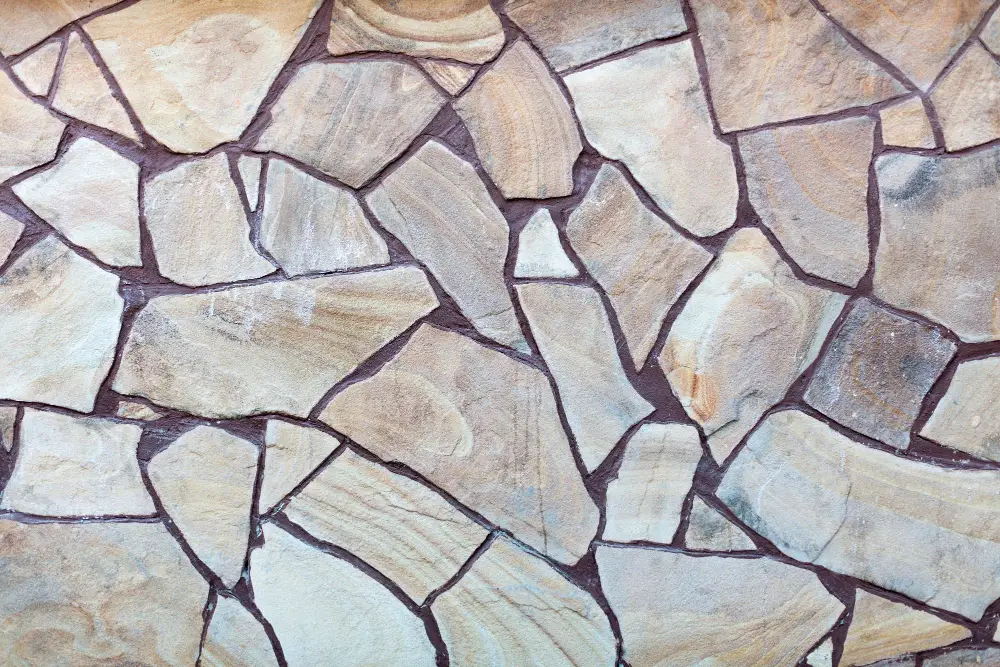
When it comes to stone outdoor kitchens, there are several flooring options available that can complement your design style while being functional at the same time.
One popular choice for stone outdoor kitchen flooring is natural flagstone. Flagstone offers a rustic look with its irregular shapes and earthy tones that blend well with nature.
It’s also slip-resistant, durable, and easy to maintain.
Another option is porcelain tile or ceramic tile designed specifically for outdoors. These tiles come in various colors, patterns, sizes which allow you to create unique designs according to your preferences while providing durability against harsh weather conditions.
If you’re looking for something more polished than flagstones or tiles then consider using stamped concrete floors which mimic the appearance of natural stones like slate or cobblestones without breaking your budget.
Grilling and Cooking Stations
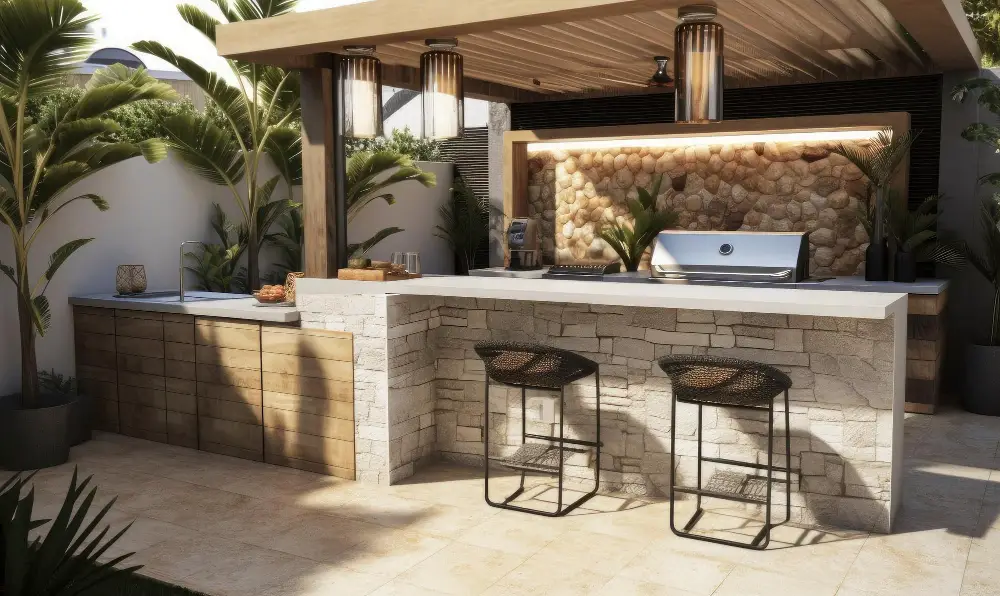
Grilling is a must-have for any outdoor kitchen, but there are many other options to consider as well. You can add a pizza oven or smoker for more variety in your cooking repertoire.
When designing the layout of your grilling and cooking stations, make sure they are easily accessible from each other so that you can move around with ease while preparing meals.
When selecting appliances such as grills or smokers, choose ones that fit within the dimensions of your stone outdoor kitchen design plan. Built-in models work best because they blend seamlessly into the overall look of the space.
Another important consideration when planning out these areas is ventilation; proper ventilation will ensure smoke doesn’t accumulate inside and ruin an otherwise perfect evening outdoors with friends and family.
Outdoor Kitchen Storage
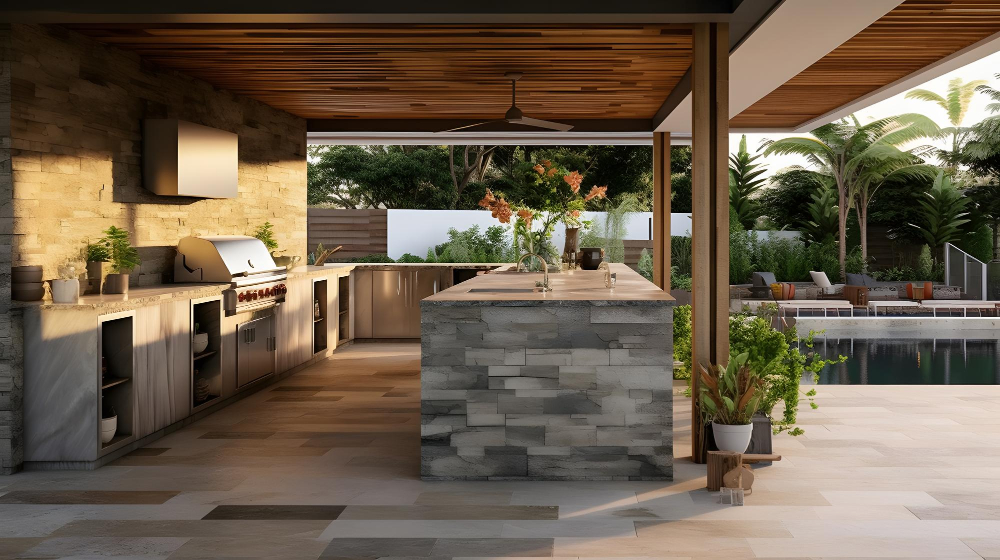
You want to make sure that all your cooking tools, utensils, and ingredients are within reach when you need them. When designing your outdoor kitchen, consider adding cabinets or drawers made from weather-resistant materials such as stainless steel or teak wood.
These materials can withstand harsh weather conditions and keep your items safe from moisture damage.
You can also install open shelves for easy access to frequently used items like plates and glasses. If you have limited space in your outdoor kitchen area, consider using vertical storage solutions such as hanging racks for pots and pans.
When selecting storage options for your stone outdoor kitchen, think about how much space you will need based on the size of the appliances you plan to use regularly. It’s always better to have more storage than not enough so that everything has a designated place.
Seating and Dining Areas
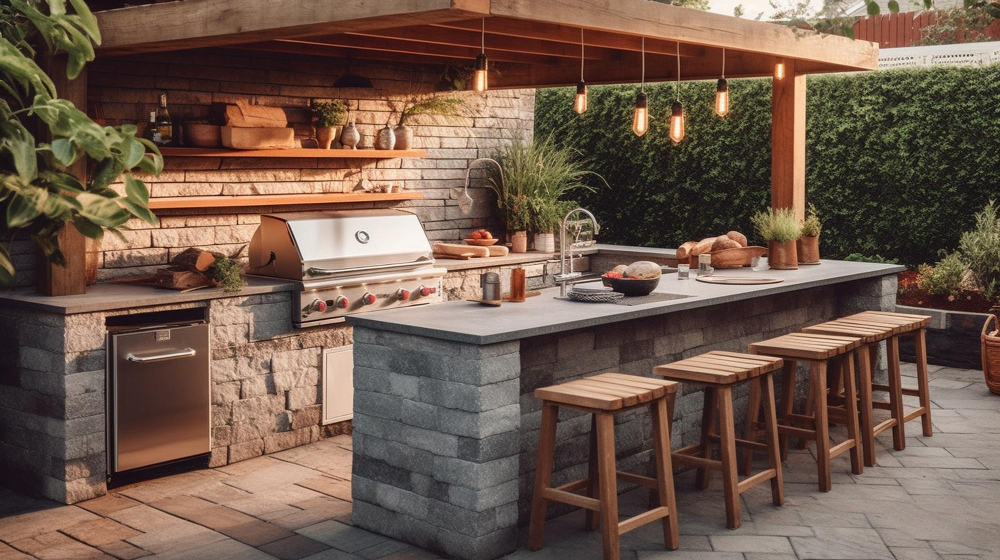
After all, what’s the point of preparing a delicious meal if you don’t have a comfortable place to enjoy it? When designing your stone outdoor kitchen, consider incorporating ample seating options for your guests. This can include built-in benches or chairs around an outdoor table or even bar-style seating at a countertop.
To create an inviting atmosphere in your dining area, add some decorative elements such as potted plants or string lights overhead. You may also want to invest in weather-resistant cushions and pillows for added comfort.
If space allows, consider adding additional features such as an outdoor fireplace or fire pit nearby for cozy ambiance during cooler evenings.
Installing Countertops and Appliances
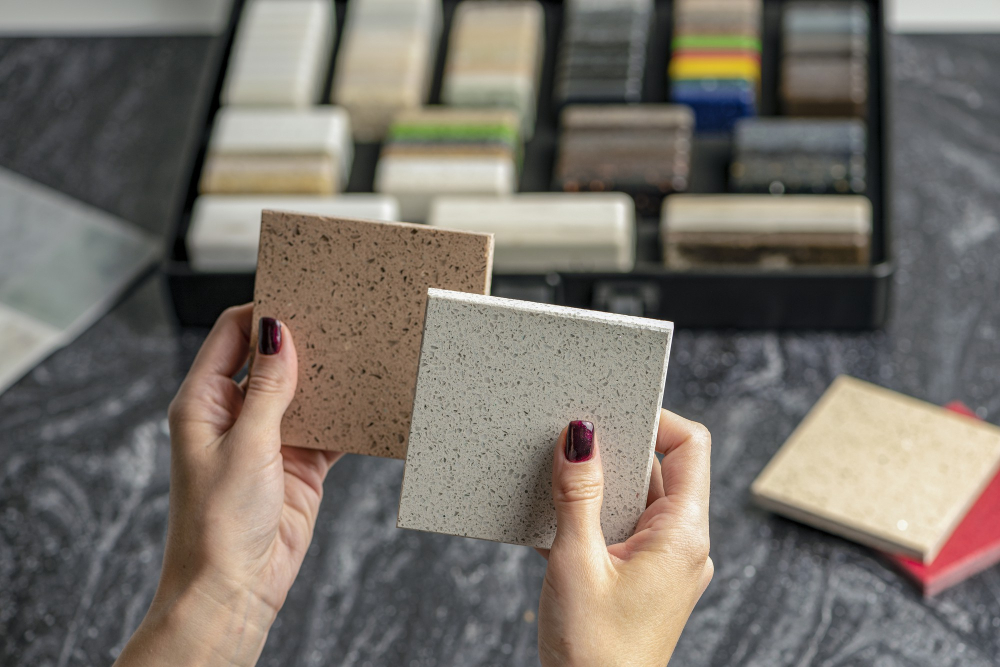
Installing countertops and appliances is a crucial step in creating a functional cooking space that meets your needs. When choosing countertops, consider materials that are durable, heat-resistant, and easy to clean such as granite or quartz.
These materials can withstand harsh weather conditions while maintaining their appearance for years.
When selecting appliances for your outdoor kitchen, make sure they are designed specifically for outdoor use with features like rust-resistant exteriors and waterproof controls. Popular appliance options include grills (gas or charcoal), refrigerators/freezers (built-in or freestanding), sinks with faucets (hot/cold water supply), ice makers/dispensers, wine coolers/beverage centers.
Adding a Roof or Pergola
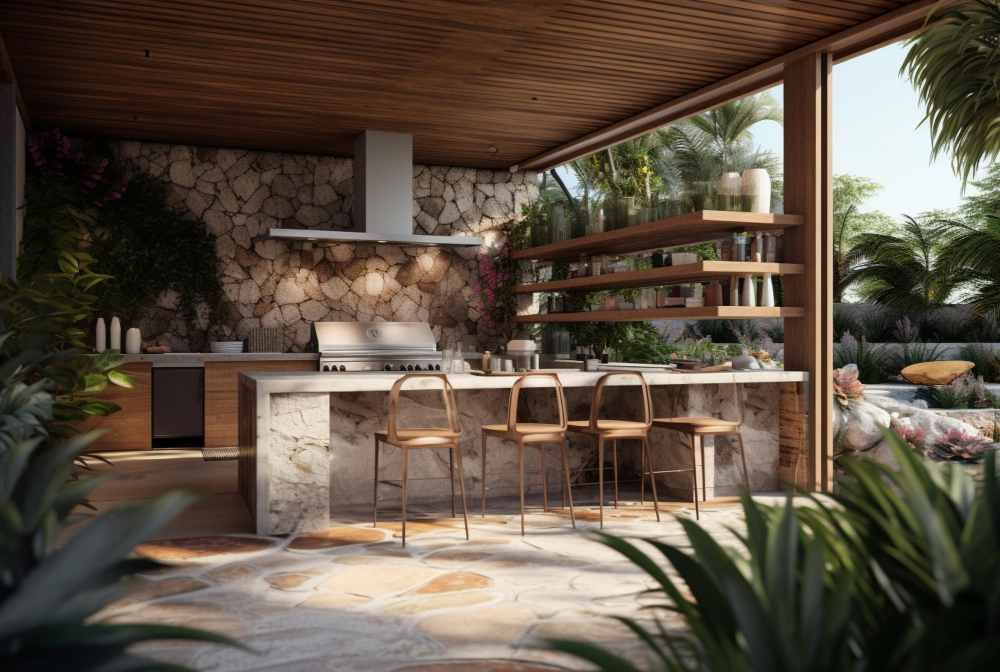
A roof will also help keep your appliances and countertops dry during rainy weather. When designing a roof or pergola, consider the style of your home as well as the overall aesthetic of your outdoor space.
You may want to choose materials that complement those used in other areas of your yard, such as wood or metal.
A pergola is an open-air structure with cross beams that create partial shade while still allowing sunlight through. It’s perfect for those who want some protection from direct sunlight but still enjoy feeling connected to nature.
On the other hand, if you prefer full coverage against rain and sun rays alike, then adding a solid roof might be more suitable for you. When building either option on top of an existing stone outdoor kitchen design make sure it is structurally sound enough to support additional weight before proceeding with construction.
Fireplace or Fire Pit Integration
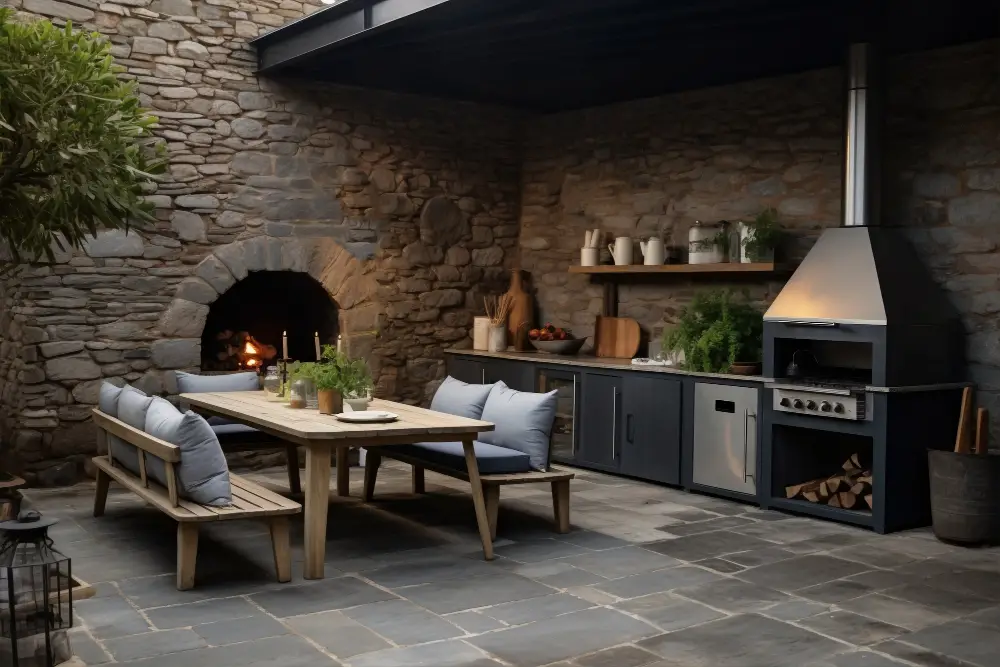
When integrating a fireplace or fire pit into your design, consider the size of your space and how it will be used. A large outdoor kitchen may benefit from a grand stone fireplace as the focal point, while smaller spaces can opt for a cozy fire pit that doubles as seating.
When selecting materials for your fireplace or fire pit, choose stones that complement the rest of your outdoor kitchen’s design. You can use natural stones like granite or limestone to create an earthy look that blends seamlessly with nature.
It’s important to note that adding a fireplace or firepit requires careful planning and installation by professionals who understand local building codes and safety regulations. Make sure you work with experienced contractors who have expertise in designing safe and functional heating elements in an outdoor setting.
Plumbing, Gas, and Electrical Setup

These are essential components of any functional outdoor kitchen that will allow you to cook with ease and convenience.
For plumbing needs such as a sink or dishwasher installation in your outdoor kitchen area, consider hiring a professional plumber who can ensure proper drainage connections. Gas lines should also be installed by professionals to avoid potential hazards like gas leaks or explosions.
Electrical wiring is another crucial aspect of an efficient outdoor cooking space. You’ll need power outlets for appliances like refrigerators or blenders as well as lighting fixtures that illuminate the entire area during nighttime use.
It’s important to keep safety in mind when setting up these systems; make sure all installations comply with local building codes and regulations before proceeding further.
Weatherproofing Your Outdoor Kitchen
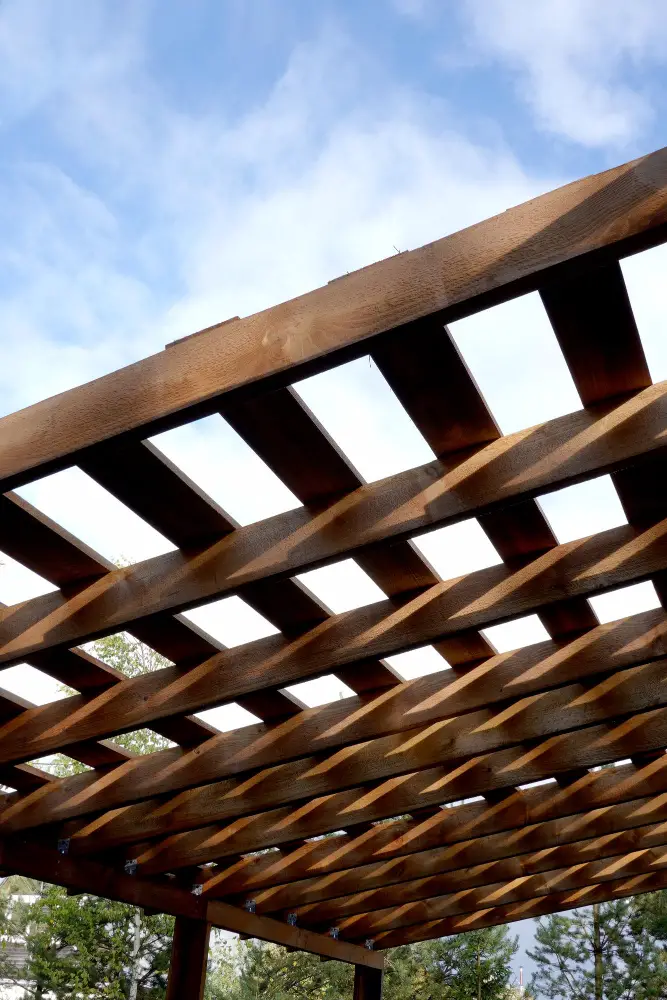
Weatherproofing is crucial for protecting your investment and ensuring that you can enjoy cooking and dining outdoors all year round.
One of the most important aspects of weatherproofing is selecting materials that are resistant to moisture, heat, and cold. Stone is an excellent choice for outdoor kitchens because it’s durable and naturally resistant to water damage.
However, some types of stone may require sealing or treatment to prevent staining or discoloration over time.
Another critical factor in weatherproofing your outdoor kitchen is proper drainage. Make sure that any water from rain or snow runoff flows away from the structure rather than pooling around its foundation.
You should also consider adding a roof or pergola over your outdoor kitchen area if possible. This will not only provide shade during hot summer days but also protect against rain showers so you can cook outside even when there’s a light drizzle.
Be sure to invest in high-quality covers for appliances such as grills and refrigerators when they’re not in use. This will help protect them from rust caused by exposure to moisture while extending their lifespan significantly.
Maintenance and Care for Stone Outdoor Kitchens

Regular cleaning will help keep the stone looking new and prevent any damage from occurring. Use a soft-bristled brush or sponge with mild soap and water to clean the surface of your countertops, flooring, and appliances.
Avoid using harsh chemicals or abrasive materials that can scratch or discolor the stone.
Sealing is also an essential part of maintaining your outdoor kitchen’s longevity as natural stones are porous materials that can absorb liquids easily if not sealed correctly. Sealing helps protect against stains caused by spills such as oil, wine, sauces among others.
It’s recommended to reseal every year depending on how often you use your outdoor kitchen; however some types of stones may require more frequent sealing than others so be sure to check with a professional before applying sealant yourself.
Lastly but importantly ensure all appliances are covered when not in use especially during winter months where snowfall could cause damage if left uncovered. By following these simple maintenance tips regularly will help prolong the life span of your beautiful Stone Outdoor Kitchen while keeping its elegance intact for years!
FAQ
What is the cheapest way to build an outdoor kitchen?
The cheapest way to build an outdoor kitchen is by utilizing salvaged materials such as reclaimed wood or recycled stone and brick, which are cost-effective and eco-friendly.
What is the best stone for outdoor kitchen?
The best stone for an outdoor kitchen is granite, as it is very durable, not easily stained by moisture or sunlight, and relatively easy to maintain.
Can I build my own outdoor kitchen?
Yes, you can build your own outdoor kitchen, making it well-appointed and allowing you to prepare and enjoy meals outdoors in the fresh air.
What are the essential components of a well-designed stone outdoor kitchen?
A well-designed stone outdoor kitchen essentially includes a grill or cooktop, countertops, storage space, and seating areas.
How can you ensure proper drainage and ventilation for a stone outdoor kitchen?
To ensure proper drainage and ventilation for a stone outdoor kitchen, incorporate necessary slope, drainage systems, and vents in the design.
What are the key factors to consider when choosing the location for a stone outdoor kitchen?
Key factors to consider when choosing a location for a stone outdoor kitchen include accessibility, level ground, sun exposure, proximity to the house, view, and utilities availability.
